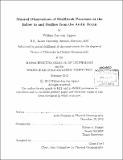Moored observations of shelfbreak processes at the inflow to and outflow from the Arctic Ocean
Author(s)
Von Appen, Wilken-Jon
DownloadFull printable version (30.75Mb)
Other Contributors
Woods Hole Oceanographic Institution.
Advisor
Robert S. Pickart.
Terms of use
Metadata
Show full item recordAbstract
Two high-resolution mooring arrays extending from the outer shelf to the mid continental slope are used to elucidate shelf-basin exchange at the inflow to and the outflow from the Arctic Ocean. Pacific Water entering the Arctic Ocean forms the Western Arctic shelfbreak current along the Beaufort Sea slope. Data from the mooring array at 152°W-approximately 150 km east of Pt. Barrow, AK-reveals that this current has two distinct states in summer depending on the water mass it transports. When advecting Alaskan Coastal Water it is surface-intensified and both baroclinically and barotropically unstable. This configuration lasts about a month with an average transport of 0.7 Sv. When advecting Chukchi Summer Water the current is bottom-intensified and is only baroclinically unstable. This state also exists for approximately a month with an average transport of 0.6 Sv. The strong mean-to-eddy energy conversion causes both configurations of the current to spin down over a distance of a few hundred kilometers, suggesting that warm Pacific Water does not enter the Canadian Arctic Archipelago via this route. Dense water formed in the Nordic Seas overflows the Denmark Strait and undergoes vortex stretching, forming intense cyclones that propagate along the East Greenland slope. Data from the mooring array at 65°N-roughly 300 km downstream of Denmark Strait-was used to determine the full water column structure of the cyclones. On average a cyclone passes the array every other day in the vicinity of the 900 m isobath, although the depth range of individual cyclones ranges between the 500 m and 1600 m isobaths. The cyclones self-propagate at 0.45 m/s and are also advected by the mean flow of 0.27 m/s, resulting in a total propagation speed of 0.72 m/s. They have a peak azimuthal speed of 0.22 m/s at a radius of 7.8 km and contain overflow water in their core. In the absence of the cyclones, the background flow is dominated by the East Greenland Spill Jet. This is shown to be a year-round feature transporting 2-4 Sv of dense water equatorward along the upper continental slope.
Description
Thesis (Ph. D. in Physical Oceanography)--Joint Program in Physical Oceanography (Massachusetts Institute of Technology, Department of Earth, Atmospheric, and Planetary Sciences; and the Woods Hole Oceanographic Institution), 2013. Cataloged from PDF version of thesis. Includes bibliographical references (p. 259-275).
Date issued
2013Department
Joint Program in Physical Oceanography; Woods Hole Oceanographic Institution; Massachusetts Institute of Technology. Department of Earth, Atmospheric, and Planetary SciencesPublisher
Massachusetts Institute of Technology
Keywords
Joint Program in Physical Oceanography., Earth, Atmospheric, and Planetary Sciences., Woods Hole Oceanographic Institution.